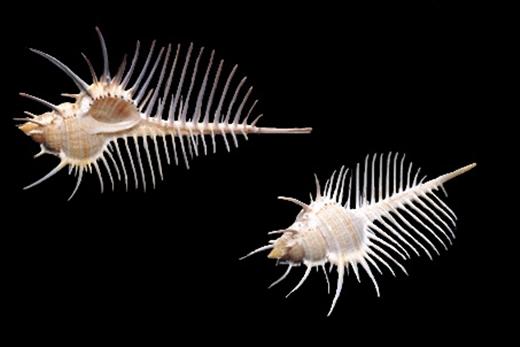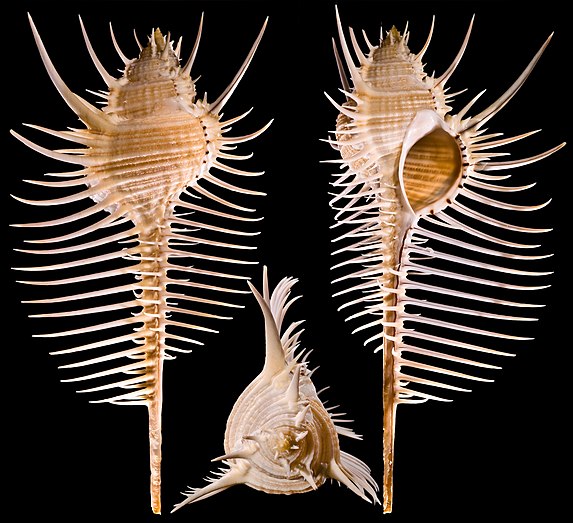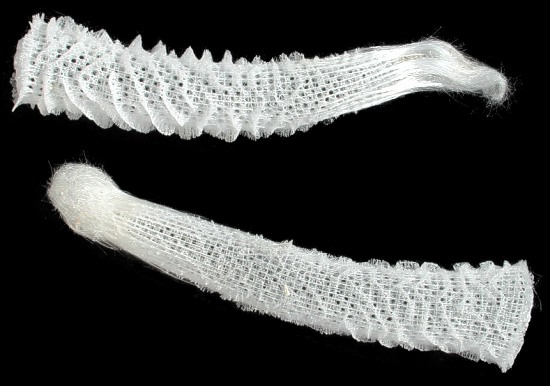As the site is updated, each listing includes the shipping cost. Some listings which I have not updated still give you calculated shipping costs based on weight and size of package. (In the sections I have updated) If you select several different listings, we will consolidate your order and charge you the actual cost of the entire package. The shipping over charge will be refunded to you, when your order is shipped.
VENUS SHELLS FOR COLLECTORS


Venus comb murex, scientific name Murex pecten, is a species of large predatory sea snail, a marine gastropod mollusk in the family Muricidae, the rock snails or murex snails.[1] The shell of this Indo-Pacific species has a very long siphonal canal and numerous spines.
This species originates from the Indo-Pacific region.
The snail's shell features an extremely long siphonal canal and is adorned with more than a hundred spines, offering protection from predators and preventing it from sinking into the soft mud. Similar to other Murex snails, its diet consists of other mollusks.
TThis species is common, yet finding perfect specimens of the shell is challenging due to the fragility of its numerous long spines. The species typically grows to a length of 4 to 6 inches.
Scientific classification
Domain: Eukaryota
Kingdom: Animalia
Phylum: Mollusca
Class: Gastropoda
Subclass: Caenogastropoda
Order: Neogastropoda
Family: Muricidae
Genus: Murex
Species: Murex pecten
Binomial name: Murex pecten
Lightfoot, 1786
(REF: Paul, C. R. (31 March 1981). "The function of the spines in Murex (Murex) pecten Lightfoot and related species (Prosobranchia: Muricidae)". Journal of Conchology. 30)
G0-17
A Venus Comb Shell measuring 2 to 4 inches ..... $1.75
G1-17
A Venus Comb Shell measuring 4 to 5 inches ..... $5.75

The Venus' flower basket (Euplectella aspergillum) belongs to the glass sponge group within the Porifera phylum. This marine sponge resides in the Pacific Ocean's deep waters, typically at depths exceeding 1,600 feet. They filter sea water to feed on plankton and marine snow, similar to other sponge species. Their skeletons are made of silica, creating a distinctive lattice of spicules, akin to other glass sponges. These sponges range from 4 to 12 inches in height, providing a haven for symbiotic shrimp. Their structure is intriguing to materials scientists due to its optical and mechanical properties, which are sometimes superior to synthetic materials. Reproduction habits are not well understood, but it's believed that the fluid dynamics within their structure may play a role, and they are thought to be hermaphroditic.
Venus' flower baskets are located in the western Pacific Ocean, close to the Philippine Islands. Other species from this genus are distributed across the world's oceans, including areas near Japan and the Indian Ocean.
The habitat of this sponge is the rocky regions of the benthic seafloor, where it remains attached to a hard substrate throughout its life. It is found at depths ranging from 330 to 3300 feet below the ocean's surface, with greater prevalence at depths beyond 1640 feet. They typically anchor themselves in soft sediments, which is facilitated by the structure of their spicules.
The benthic region of the ocean begins at the shore line (intertidal or littoral zone) and extends downward along the surface of the continental shelf out to sea. Thus, the region incorporates a great variety of physical conditions differing in: depth, light penetration and pressure.
These animals possess a body structure that is a thin-walled, cylindrical, vase-shaped tube with a sizable central atrium. Their bodies are entirely made of silica, taking the form of six-pointed siliceous spicules, earning them the common name of glass sponges. Each spicule consists of three perpendicular rays, resulting in six points. These spicules, microscopic pin-like structures within the sponge's tissues, provide essential structural support. The specific arrangement of spicule forms within a sponge's tissues aids in species identification. For glass sponges, the spicules interlock to create an extremely fine mesh, endowing the sponge's body with a level of rigidity unique among sponge species, enabling them to endure the great depths of the water column.
TThese sponges are commonly known to shelter glass sponge shrimp, often a breeding pair, which are usually too large to leave the sponge's lattice. As a result, they reside within and around these sponges, engaging in a mutualistic relationship with their host until their demise. The shrimp live and reproduce within the protection provided by the sponge, and reciprocate by cleaning its interior. This symbiotic association might have contributed to the sponge becoming a symbol of eternal love in Japan, where the skeletons of these sponges are given as wedding presents.
Scientific classification
Domain: Eukaryota
Kingdom: Animalia
Phylum: Porifera
Class: Hexactinellida
Order: Lyssacinosida
Family: Euplectellidae
Genus: Euplectella
Species: Euplectellidae aspergillum
Binomial name: Euplectella aspergillum
Owen, 1841
(REF:Are glass sponges made of glass? : Ocean Exploration Facts: NOAA Office of Ocean Exploration and Research)(REF: "Secrets of the Venus' Flower Basket")(REF: Falcucci, Giacomo; Amati, Giorgio; Fanelli, Pierluigi; Krastev, Vesselin K.; Polverino, Giovanni; Porfiri, Maurizio; Succi, Sauro (2021-07-22). "Extreme flow simulations reveal skeletal adaptations of deep-sea sponges". Nature. 595)(REF: Schoepf, Verena; Ross, Claire. "A deep-sea love story". Schmidt Ocean Institute.)
GG1-17
A Venus Flower Basket measuring 7 TO 8 inches..... $5.75